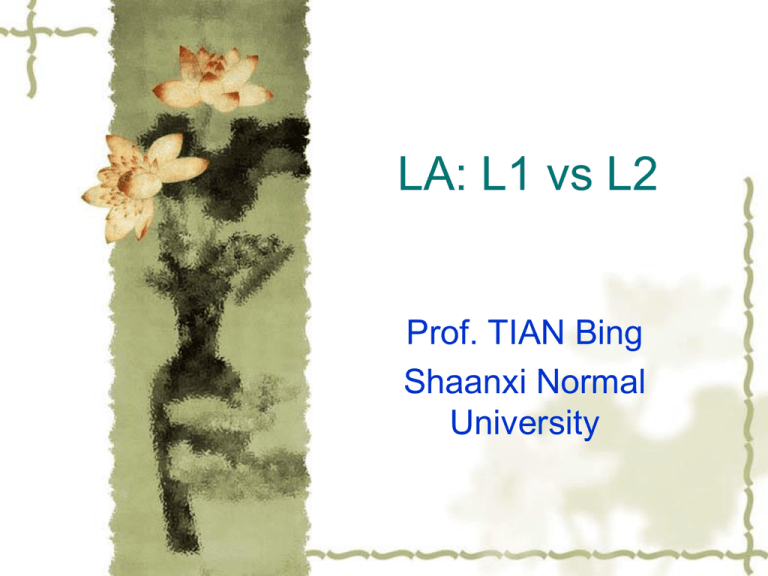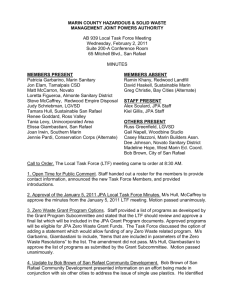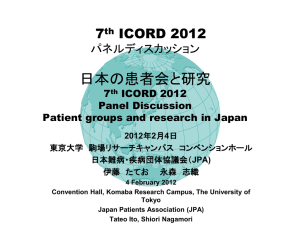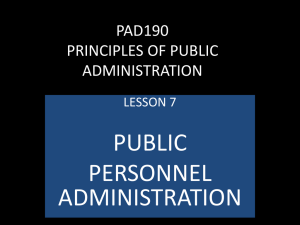8.3 Non-Native-Like Outcomes in L2A
advertisement

LA: L1 vs L2 Prof. TIAN Bing Shaanxi Normal University I. overvie w & history An Introduction IV. Methods and Testing Traditional Thoughts of Education Research M ethods Foreign Language Education Language Testing. (Pedagogical) Lexicography V. Learning II. Lg Description Language Descriptions Language Corpora. Stylistics. Discourse Analysis. vs CA Second Language Learning. Individual Differences in Second Language Learning. Social Influences on Language Learning. VI. Teaching III. Cognitive & Social Fashions in Language Teaching Language Acquisition: L1 vs L2 Language, Thought, and Culture. Language and Gender. Language and Politics. Language Teacher Education. World Englishes. The Practice of LSP Bilingual Education. M ethodology. Computer Assisted Language Learning Fig. 0 A Bird’s-Eye-Vie w of Applied Linguistic Studies 1. Introduction 1. Introduction 2. Why study ultimate attainment (UA)? 3. Non-native-like outcomes in L2A 4. A closer look at the concept 5. A note on fossilization 6. UA and the critical period hypothesis: the age function 7. The incidence of native-like attainment 8. Initial state, end state, and universal grammar 9. Dissociations and asymmetries 10. UA and cortical function 11. Conclusion 1. Introduction In second language acquisition (L2A) research, ultimate attainment refers to the outcome or end point of acquisition, and is used interchangeably with the terms final state, end state, and asymptote. “Ultimate” is not to be thought of as synonymous with “native-like,” although native-likeness is one of the observed outcomes of L2A. the study of ultimate attainment engages such core L2A issues as native language influence, access to Universal Grammar (UG), maturational effects, and fossilization. 8.2 Why Study Ultimate Attainment? In the most general terms, L2A theory tackles the question of the resemblance of L2A to L1A. Perhaps the most basic issue in L2A research is whether this difference in ends (i.e., final states) implies different means (i.e., learning procedures), as suggested by BleyVroman’s (1989) Fundamental Difference Hypothesis. The age factor in L2A is another domain in which ultimate attainment data figure prominently. It is widely recognized that the age at which L2A begins is reliably the strongest predictor of level of ultimate attainment. Researchers also look for evidence of discontinuity in the age function, which would suggest the start of a decline from peak levels of sensitivity (e.g., Flege, 1999). With end-state data one brings a privileged perspective to the perennial question of native language effects. In particular, one looks at the pairing of different L1s with a single L2 to determine if there is a corresponding varying incidence of nativelikeness. In addition, there is the question of whether some areas of the L2 grammar, but not others, are ultimately mastered, and if this asymmetry is a function of the learner’s native language (Bialystok & Hakuta, 1999; Bialystok & Miller, 1999). 8.3 Non-Native-Like Outcomes in L2A As pointed out by Sorace (1993, pp. 23–4), learners at the end state may have a grammar of the L2 that lacks some property P of the target grammar; accordingly this grammar is said to be incomplete. Another type of nonnative-like grammatical representation is divergence, whereby property P is instantiated but in a manner that is not consistent with that property of the target grammar. A variant of incompleteness in grammatical representation is indeterminacy. Non-native-like outcomes have been examined in the context of UG. 8.4 A Closer Look at the Concept First let us recall that, as we noted at the beginning of this chapter, “ultimate attainment” is not to be misunderstood as suggesting native-likeness. Rather, it refers to the end point of L2A, irrespective of degree of approximation to the native grammar. Moving beyond this clarification, let us try to pin down conceptually what is meant by the term. At a basic level of understanding, the notion of end state in L2A is no different from its counterpart in L1A, as both denote the mature grammar. However, as we have just seen, the end state of L2A may be nondeterministic, and thereby differ qualitatively from the L1A end state. As a result, the idealization of the mature grammar as a “steady state grammar” must be finessed: compared with L1, the L2 steady state seems “unsteady,” as it admits more variability in surface realizations and more uncertainty of intuitions. This is the nature of an indeterminate end-state L2 grammar, and as such this outcome should not be confused with “backsliding” or ongoing grammatical re-representation, which would suggest learning still in progress. We are still left with the matter of determining when the end state has been reached. For example, how do we know that the abstract features associated with functional heads have been set, permanently, to native-like or nonnative- like values (see, e.g., Lardiere, 1998)? To a large extent, the answer to this question depends on the adequacy of our methods for probing learner grammars. That is, we need reliable data – ideally, convergent evidence from multiple elicitation methods – and sensible interpretation of these data. 8.5 A Note on Fossilization Since the term was popularized in the L2A context by Selinker (1972), “fossilization” has been understood in various ways, among them, as a process, as a cognitive mechanism, and as a result of learning. Selinker and Han (2000) catalogue various learner behaviors that researchers have associated with fossilization. These include backsliding, low proficiency, errors that are impervious to negative evidence, and persistent non-targetlike performance. They also list a host of proposed explanations for these behaviors, such as simplification, avoidance, end of sensitivity to language data, and lack of understanding, acculturation [文化适应], input, or corrective feedback. Unquestionably, the study of various representational and acquisitional facts that might fall under the umbrella of fossilization has advanced our knowledge of L2A. But among researchers there is disagreement at the most basic level, for example, on whether it is a process or a product, whether its domain extends to L1A, and whether it refers to invariant non-native forms or variable non-native forms (Han, 1998). Fossilization appears to be a protean [多变的], catch-all term that fails to capture a unitary or even coherent construct. This being the case, one must recognize the limitations of attempts to characterize the nature of fossilization. For the sake of descriptive and explanatory precision, it may be more reasonable to investigate discrete products, processes, behaviors, and epistemological states of L2A. 3.6 UA and the Critical Period Hypothesis: The Age Function A key feature of the Critical Period Hypothesis for second language acquisition (CPH/L2A) is the prediction that native-like attainment in a second language will not be possible if the start of L2A is delayed past a certain critical age. Because the CPH/L2A addresses the upper limits of attainment possible in L2A, the only evidence that is decisively relevant to the adequacy of the CPH/L2A comes from learners at the L2A end state. As a general rule, level of ultimate attainment in L2A is predicted by age of arrival in the target country. After age of arrival, the strongest predictor appears to be amount of L2 input and interaction. Not all apparent age effects are maturational in nature. Johnson andNewport (1989), articulating the logic of a critical period for L2A, point outthat attainment should correlate negatively with age of arrival (AOA), just incases of learners whose AOAs predate the end of maturation. Researchers (e.g., Bialystok & Hakuta, 1999; Flege, 1999) have also argued that a distribution of end-state performance, to be consistent with the CPH/ L2A, should incorporate a point of inflection, an “elbow” corresponding to the start of a decline in learning ability, i.e., the offset of the period of peak sensitivity. In contrast, a meta-analysis of L2A end-state studies (Birdsong, in press) reveals a consistent picture of ongoing declines in attainment over the span of AOA. These indefinitely-persisting age effects usually take the form of a simple straight-line decline or a stretched “7” shape, the bottom end pulled rightward. With no apparent end to the decline of sensitivity, the notion of a bounded time frame, or critical “period” of sensitivity, fails to match up with the ultimate attainment data. 8.7 The Incidence of NativeLike Attainment Along with post-maturational age effects in ultimate attainment, nativelikeness among late learners of L2 has been considered as a criterion for falsification of the CPH/L2A. In fact, Long (1990, p. 255) maintained that a single case of demonstrable native-like proficiency among late learners would be sufficient to refute the CPH/L2A. Non-native-likeness was the presumed end state of postpubertal L2A, and there was little or no empirical evidence to the contrary (see the comprehensive review by Long, 1990). Estimates of the incidence of native-likeness ranged from near 0 (BleyVroman, 1989) to 5 percent (Selinker, 1972). Success in adult L2A was thought to be so rare as to be pathological, in the sense that the rate of native-like attainment could be compared to the rate of failure to acquire a first language (Bley-Vroman, 1989). Mainstream texts deemed a lack of mastery a basic characteristic of late L2A, a fact in need of an explanation (e.g., Towell & Hawkins, 1994). Two studies in particular contributed to this view: Coppieters (1987) and Johnson and Newport (1989). Coppieters studied 21 near-native speakers of French from varying L1 backgrounds. All were late learners who had resided in France for at least five and a half years. Participants judged the grammaticality of 107 complex French sentences, some of which exemplified languagespecific structures, such as the choice of subject pronoun in identificational constructions: A similar result was obtained in the Johnson and Newport (1989) study. Among their 23 late learners, the highest score was 254 out of 276. The lowest score among native controls was 265. The researchers consider this depressed performance to be consistent with the idea of maturational constraints in L2A. Indeed, among late learners, non-native-likeness is thought to be an inevitable outcome: “for adults, later age of acquisition determines that one will not become native or near-native in a language” (Johnson & Newport, 1989, p. 81). In contrast to the general pattern of accentedness observed in late L2A, Bongaerts (1999) has demonstrated that Dutch late learners of English and French (age of exposure > 12 years) can speak without accent, though the rate of native-likeness is lower for French L2 than for English L2. Some researchers in bilingualism and neurocognitive development dispute the a priori appropriateness of the native standard for the study of the L2 end state. Further, one could argue that the criterion of nativelikeness sets the bar too high, since late learners routinely attain quite impressive, if not native-like, levels of L2 proficiency and linguistic knowledge. From the perspective of research in developmental psychology and language acquisition, however, the native competence level affords a benchmark for comparison that permits ready interpretation of experimental results (see also Mack, 1997). Perhaps most importantly, demonstrations of native-likeness represent dramatic counterpoints to received views of the upper limits of L2A, whereby the outcome of L2A is doomed to be inferior to that of L1A. 3.8 Initial State, End State, and Universal Grammar Recent research in the UG/L2A framework has stressed the theoretical relationship of initial state competence to final state competence (e.g., Hardin, 2001; White, 2000). In the most basic terms, researchers make predictions about end-state competence based on a theorized initialstate grammar. Thus, for example, if the L2A initial state is not characterized by transfer from the L1, and there is full access to UG, then native-like competence at the end states hould be predicted. In contrast, if the initial state of L2A is the full L1 grammar, and there is no access to UG, then a failure to attain native-like competence at L2 ultimate attainment is expected. Under this approach additional aspects of the end-state grammar may also be anticipated, such as the nature of the grammar (e.g., incomplete, divergent, indeterminate), “rogue” or non-UG-compliant features, and effects of L1-L2 pairing. Hardin (2001) examines in detail the relationships between initial and end states in L2A. It is important to note that a native-like outcome in L2A does not necessarily imply that UG is accessed. 8.9 Dissociations and Asymmetries Pinker (e.g., Pinker, 1999) proposes a dual-mechanism model for knowledge of regular inflectional morphology (e.g., verb pasts such as walk-ed; noun pluralssuch as cup-s) versus irregular morphology (run – ran; child – children). Under this model, computation of regulars involves rulebased, or symbolic, processing of the compositional features stem + ending, whereas irregulars are accessed as individual units from associative memory. Unlike regulars, the representation of irregulars is sensitive to the items’ frequency in the input. Were verb pasts and noun plurals represented under a single-system connectionist model, on the other hand, then there would be no symbolic manipulation, and all retrieval would require accessing inflected forms from (frequency-sensitive) associative memory. There is behavioral and neurofunctional evidence of dissociations between rule-based and lexical knowledge. Birdsong and Flege (2001) hypothesized that input frequency should be a factor in knowledge of irregular, but not regular forms (e.g., Beck, 1997). Interestingly, Brovetto and Ullman (2001) in a study of oral production of regular and irregular English pasts by 32 Spanish and 32 Chinese natives (AOA ≥ 17 years) with a minimum of three years’ US residence, found that performance on both irregulars and regulars was sensitive to frequency. One may speculate that declarative memory, which provides for learning and storage of facts, names, and arbitrary and irregular forms, is more susceptible to aging effects than the procedural memory system, which may be responsible for rule-based learning. Moving beyond speculation as to the underlying causes of regular-irregular dissociations over the age function, it is clear that the question of age effects in late L2A cannot be approached monolithically. 8.10 Ultimate Attainment and Cortical Function Modern technologies such as Functional Magnetic Resonance Imaging (fMRI), Positron Emission Tomography (PET), and Event-Related Brain Potentials (ERPs) allow L2A researchers to investigate the neural systems involved in language processing. In most cases, work does not address the L2A end state specifically, but is concerned with the age at which L2 acquisition was begun and L2 proficiency. A recurrent goal in this research is determining the degree to which L1 processing and L2 processing involve similar neural substrates. For example, Weber-Fox and Neville (1999), in a study of Sinophone learners of English with over five years’ immersion, found that the neural subsystems involved in language processing differ as a function of age of acquisition. In a study of highly proficient late L2 learners (mean initial exposure = 12.25 years of age), Illes et al. (1999) used fMRI to investigate the semantic processing of nouns by eight English-Spanish bilinguals. Comparing the scans of processing in the two languages, the researchers found no activity differences in either the left or right inferior frontal gyrus [脑会], and both languages seemed to be dominantly lateralized in the left hemisphere. At least with respect to vocabulary, Illes et al. (1999) suggest that, irrespective of the age of acquisition, increasing proficiency in the L2 leads to a common cortical representation of the two languages. 8.11 Conclusion The study of learners immersed in an L2 for significant lengths of time has led to significant advances in the understanding of the nature of L2A. Researchers recognize that a range of variables – in particular, age of immersion, L1-L2 pairings, and quantity of input – may interactively determine the level of ultimate attainment. As we move forward, we are alert to the need for finer-grained investigation of the limits of bilingualism, as suggested by the discovery of asymmetries at the end state, and their relation to representational variables such as the learner’s dominant language. Granularity is further motivated by demonstrations that discrepant effects of AOA are associated with various features of the language, possibly reflecting principled cognitive distinctions such as declarativized versus proceduralized knowledge, or symbolic computation versus lexical retrieval. A dozen or so years ago the study of ultimate attainment in L2A was in its infancy. The field is now entering adolescence (and, to paraphrase Oscar Wilde’s witticism, is no longer young enough to know everything). With additional nourishment from cognitive neuroscience, linguistic theory, and developmental psychology, there is every reason to believe that the spurts of growth – and sophistication – will continue. Thanks!








